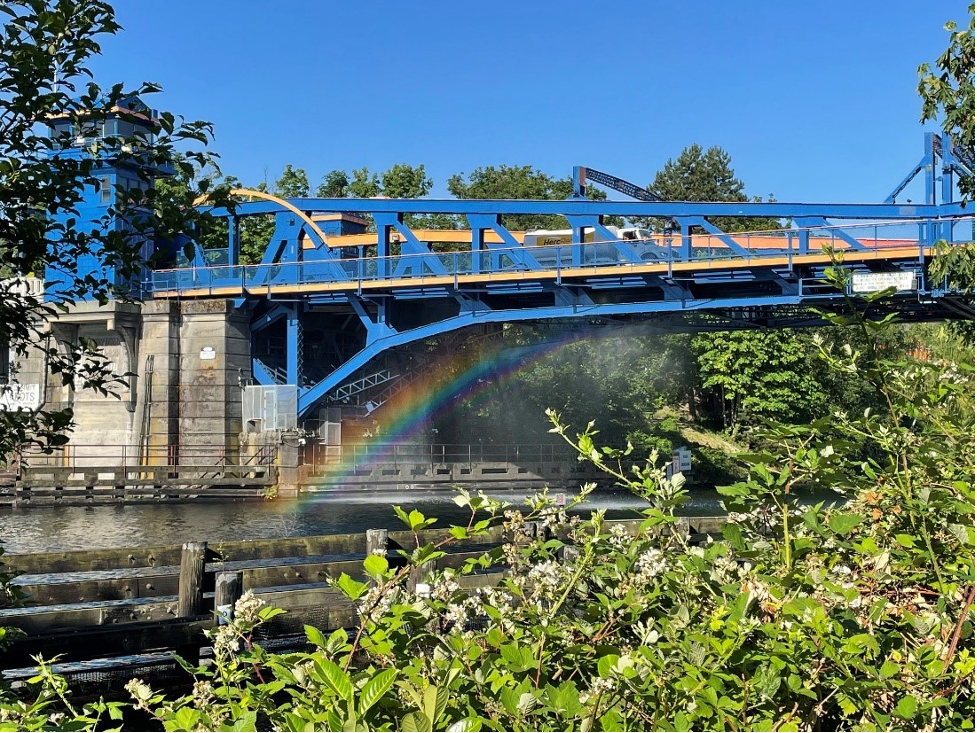 Crews completed urgent pavement repairs on West Marginal Way just north of Highland Park Way SW. Photo: SDOT
Crews completed urgent pavement repairs on West Marginal Way just north of Highland Park Way SW. Photo: SDOT Summary
- Our talented Crews have been repairing roads that were damaged by the summer’s extreme heat.
- Crews keep the city moving no matter the weather condition. In this blog, we’ve shared the latest on the repairs.
- Among more, when temperatures reach 85 degrees or higher, we spray down our steel draw bridges to keep them cool so that they can function properly.
- The City of Seattle is working to reduce carbon pollution from transportation and adapt our infrastructure to withstand rising temperatures.
Seattle’s historic high summer temperatures caused severe damage to roads. Our Crews have been hard at work this month to repair them.
Our engineers evaluated the reported road damage around the city and prioritized repairs based on public safety and impact to the traveling public.
Our Crews quickly got to work and repaired severe pavement damage on West Marginal Way north of Highland Park Way SW where the concrete buckled in the heat. We also completed repair work to damaged concrete on 36th Ave SW between SW Avalon Way and SW Oregon St. Crews demolished, removed, and replaced eight massive concrete panels ahead of schedule.

Before repair work on S Angeline St and 38th Ave S 
After repair work on S Angeline St and 38th Ave S 
Before repair work on SW Holly St between 40th Ave and 41st Ave SW 
After repair work on SW Holly St between 40th Ave and 41st Ave SW
We also finished work on NE 68th St (between 51st Ave NE and 52nd Ave N) and completed temporary repairs at the intersection of S Angeline St and 38th Ave S and SW Holly St (between 40th Ave SW and 41st Ave SW).
A huge thanks to our amazing Crews who worked day in and day out (and sometimes overnight!) to keep Seattle moving.
We rely on our Crews to help us prepare and respond to whatever Mother Nature has in store for us (rain, sleet, snow, or record-setting heat). Our Crews’ dedication and resilience is a major reason our transportation system continues to work for the traveling public.

We’re prepared for more heat.
When temperatures reach 85 degrees or higher, we proactively spray down our steel draw bridges to keep them cool as part of our ongoing bridge maintenance program. This is necessary because the high temperatures can cause the steel to expand and potentially create problems for opening and closing functions.

As climate change makes extreme heat more common, we’re preparing our city’s transportation infrastructure and roads for the future.
Reducing carbon pollution
To do our part to slow the pace of climate change, we’re working to reduce carbon pollution from our transportation systems. We’re building more protected bike lanes and dedicated transit lanes throughout the city to make it easier and safer for you to walk, bike, roll, scoot, and take transit, which are climate-friendly alternatives to traveling by car. We’ve also committed to electrifying our transportation system to reduce harmful emissions and make Seattle a healthy and more resilient city.

Prioritizing investments
We’re actively working to fix the inequities to lower-income residents and neighborhoods who are most vulnerable to climate change, least equipped to adapt, and who are already disproportionately bearing the health and financial impacts of climate change by prioritizing climate-friendly investments, design incentives, and deploying pilot projects.
Adapting infrastructure
We’ll also need to adapt our existing infrastructure to withstand rising temperatures. This involves doing more preventative maintenance and updating our standards as temperatures increase. For example, we can expect to do more work like sealing joints and cracks on asphalt and concrete, which is common in hotter cities like Phoenix and Las Vegas.
Managing trees, plants, and green infrastructure
We also manage trees, plants, and other green infrastructure to improve the health, safety, and welfare of people who walk and bike and to protect streets from the hot sun.

Our Landscape Architect’s Office staff review every SDOT Capital Project, public, or privately funded development in Seattle to retain and protect existing mature trees, and maximize shade and canopy cover over buildings, streets, and sidewalks. We’re also working to upgrade irrigation systems so that we can operate them remotely using smart controllers along with flow control devices to minimize water use in medians, planting strips, and landscaped areas citywide.
Adapting best practices
In coordination with all other departments in the City of Seattle, we’re adapting our best practices for design, construction, and management of infrastructure to withstand rising temperatures.